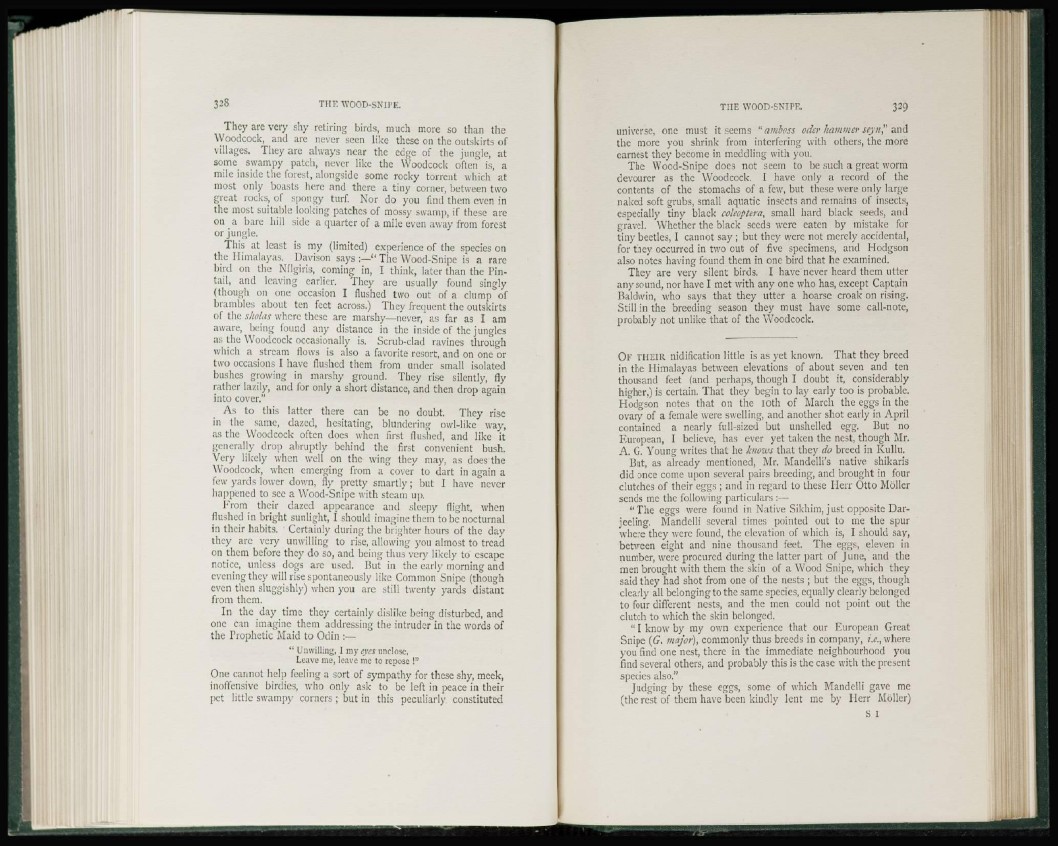
They are very shy retiring birds, much more so than the
Woodcock, and are never seen like these on the outskirts of
villages. They are always near the edge of the jungle, at
some swampy patch, never like the Woodcock often is, a
mile inside the forest, alongside some rocky torrent which at
most only boasts here and there a tiny corner, between two
great rocks, of spongy turf. Nor do you find them even in
the most suitable looking patches of mossy swamp, if these are
on a bare hill side a quarter of a mile even away from forest
or jungle.
This at least is my (limited) experience of the species on
the Himalayas. Davison says :—" The Wood-Snipe is a rare
bird on the NMgiris, coming in, I think, later than the Pintail,
and leaving earlier. They are usually found singly
(though on one occasion I flushed two out of a clump of
brambles about ten feet across.) They frequent the outskirts
of the sholas where these are marshy—never, as far as I am
aware, being found any distance in the inside of the jungles
as the Woodcock occasionally is. Scrub-clad ravines through
which a stream flows is also a favorite resort, and on one or
two occasions I have flushed them from under small isolated
bushes growing in marshy ground. They rise silently, fly
rather lazily, and for only a short distance, and then drop again
into cover."
As to this latter there can be no doubt. They rise
in the same, dazed, hesitating, blundering owl-like way,
as the Woodcock often does when first flushed, and like it
generally drop abruptly behind the first convenient bush.
Very likely when well on the wing they may, as does the
Woodcock, when emerging from a cover to dart in again a
few yards lower down, fly pretty smartly ; but I have never
happened to sec a Wood-Snipe with steam up.
From their dazed appearance and sleepy flight, when
flushed in bright sunlight, I should imagine them to be nocturnal
in their habits. Certainly during the brighter hours of the day
they arc very unwilling to rise, allowing you almost to tread
on them before they do so, and being thus very likely to escape
notice, unless dogs are used, But in the early morning and
evening they will rise spontaneously like Common Snipe (though
even then sluggishly) when you are still twenty yards distant
from them.
In the day time they certainly dislike being disturbed, and
one can imagine them addressing the intruder in the words of
the Prophetic Maid to Odin :—
" Unwilling, I my eyes unclose,
Leave me, leave mc to repose !"
One cannot help feeling a sort of sympathy for these shy, meek,
inoffensive birdies, who only ask to be left in peace in their
pet little swampy corners ; but in this peculiarly constituted
universe, one must it seems " amhoss oder hammer sey«," and
the more you shrink from interfering with others, the more
earnest they become in meddling with you.
The Wood-Snipe docs not seem to be such a great worm
devourcr as the Woodcock. I have only a record of the
contents of the stomachs of a few, but these were only large
naked soft grubs, small aquatic insects and remains of insects,
especially tiny black coleóptera, small hard black seeds, and
gravel. Whether the black seeds were eaten by mistake for
tiny beetles, I cannot say ; but they were not merely accidental,
for they occurred in two out of five specimens, and Hodgson
also notes having found them in one bird that he examined.
They are very silent birds. I have never heard them utter
any sound, nor have I met with any one who has, except Captain
Baldwin, who says that they utter a hoarse croak on rising.
Still in the breeding season they must have some call-note,
probably not unlike that of the Woodcock.
OF THEIR nidification little is as yet known. That they breed
in the Himalayas between elevations of about seven and ten
thousand feet (and perhaps, though I doubt it, considerably
higher,) is certain. That they begin to lay early too is probable.
Hodgson notes that on the 10th of March the eggs in the
ovary of a female were swelling, and another shot early in April
contained a nearly full-sized but unshelled egg. But no
European, I believe, has ever yet taken the nest, though Mr.
A. G. Young writes that he knows that they do breed in Kullu.
But, as already mentioned, Mr. Mandelli's native shikaris
did once come upon several pairs breeding, and brought in four
clutches of their eggs ; and in regard to these Herr Otto Moller
sends mc the following particulars :—
"The eggs were found in Native Sikhim, just opposite Darjeeling.
Mandclli several times pointed out to me the spur
where they were found, the elevation of which is, I should say,
between eight and nine thousand feet. The eggs, eleven in
number, were procured during the latter part of June, and the
men brought with them the skin of a Wood Snipe, which they
said they had shot from one of the nests ; but the eggs, though
clearly all belonging to the same species, equally clearly belonged
to four different nests, and the men could not point out the
clutch to which the skin belonged.
" I know by my own experience that our European Great
Snipe (67. major), commonly thus breeds in company, i.e., where
you find one nest, there in the immediate neighbourhood you
find several others, and probably this is the case with the present
species also."
Judging by these eggs, some of which Mandclli gave me
(the rest of them have been kindly lent mc by Herr Moller)
S I